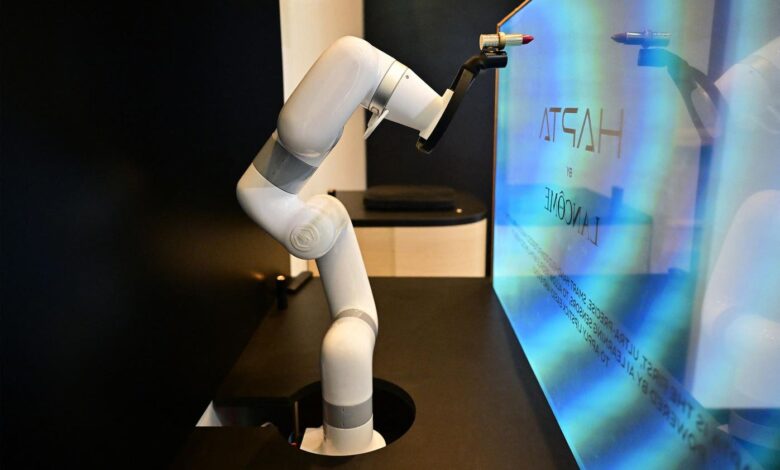How Luxury Brands Bet On Generative AI To Solve Old And New Challenges

Lancôme, part of the L’Oreal Luxury Products division, demonstrates its precise computerized makeup … [+]
Generative AI (GenAI) has taken the world by storm since OpenAI released ChatGPT in late 2022, a version that suddenly captured the minds of the public thanks to the richness and diversity of the responses it could bring to users’ questions.
For the Wall Street Journal, GenAI stands to double the rate of US productivity growth after a decade of widespread adoption and to add trillions of dollars a year to global economic output.
In contrast to what happened a decade ago, when luxury brands almost denied the relevance of digital, they have been quick this time to join the bandwagon. It seems they have good reasons. According to McKinsey, “In the next three to five years, generative AI could add $150 billion, conservatively, and up to $275 billion to the apparel, fashion, and luxury sectors’ operating profits.” But have they?
In early 2023, Kering, the parent of brands including Gucci and Pomellato, launched an experimental platform called KNXT, where users can chat with Madeline, a ChatGPT-based luxury personal shopper. “Madeline can understand natural language requests and suggest products from Kering’s portfolio, as well as provide insights on fashion trends and destinations,” said Bing’s AI Chat when I queried which type of use cases could emerge for luxury brands. In May 2024, Madeline was under “maintenance”, with no announced reopening date.
The current article explores GenAI opportunities in luxury sectors. The following, its limitations.
Luxury brands have taken four avenues to experiment with GenAI to create and capture value. The central message is that technology is never an end per se. When deciding where to experiment with this technology, decision makers need to define first the strategic purpose (the pain point to be solved) and vision.
What’s changing with GenAI
OpenAI’s CHAT GPT has taken the world by storm, including luxury brands
What’s different with GenAI compared to previous generations of AI (they go all the way to 1956)? LLMs are trained on even more massive amounts of data (in fact, the global internet content), allowing them to generate human-like language or images. The technology is based on deep learning approaches where the neural network identifies patterns and relationships in existing data sets (typically, all types of information available online) to create new content where none existed before, based on contextualized probabilistic calculations of what could complement the missing data series. This content can take the form of text, image, video, audio, and code.
Today’s GenAI makes two breakthroughs. These new tools are not search engines based on facts and reality; they are tools for suggesting possible solutions and ideas when none is defined and in situations of ambiguity. As Amit Joshi, professor at IMD put it: “If you are looking for a pink tiger, Google would scan the internet and if there is none, there is none. ChatGPT could give you ideas of what the pink tiger could look like. So, it is opening doors to creativity. It is inspiring what could be.” This was never achieved before.
Secondly, GenAI enables humans to speak with computers in their native language, which is also revolutionary.
Four paths to value creation
So, what can luxury brands do with GenAI? First, take note that the most promising applications will be those run and trained on company specific data (whether it is films, text, videos, photos, spreadsheets, etc.), not least because this is the best way of avoiding the inadvertent violation of intellectual property from apps trained on the global internet.
A first way of looking at luxury brands’ current experiments is to differentiate between two sorts of gains. Some of the experiments currently taking place aim to produce new sources of value (let’s call them creativity gains). Others aim at cutting time and costs while increasing scale (efficiency gains). A second way of analyzing brands’ experiments is to look at who benefits: some GenAI applications are directed to the brands’ internal operations and employees (internalization) while others are directed to the brands’ ecosystem of customers, partners, suppliers and even criminals (externalization).
Crossing these two lines of experiments yields four distinct and complementary paths. Each comes with its own set of examples and applications.
Externally focused GenAI applications for efficiency gains
Fake luxury goods are hard to detect online. Burberry is now using its own AI solution to spot them … [+]
Fighting counterfeits at scale. Fakes, usually supplied by criminal networks, costs luxury brands billions of dollars a year not just due to lost sales but also because of monitoring and prosecuting costs. Artificial intelligence can streamline this costly process by scanning the content available on the internet at scale. For example, Burberry uses an application that scans photographs to predict if a product is fake or not. It analyses every detail of the product such as the weaving and texture. Any flaws are taken as a sign the item isn’t real.
Streamlining customer service. GenAI has started to save customers’ time and frustration with the roll out of AI-powered chatbot agents in call centers and ecommerce sites. Those chatbots can now speak in an almost infinite number of languages. Especially in luxury, brands need to remember that any AI-powered chatbot should feel completely humanized since it is the ability of the machine to create human-like positive emotions that makes or break customer satisfaction, a recent study found.
Externally-focused GenAI applications for creativity gains
Here, brands deploy GenAI not so much to do “less of” or automate existing processes to save costs, but to generate new sources of values, experiences and possibilities for their customers and external stakeholders that would hardly exist without.
According to Bing’s AI Chat, GenAI “can help luxury brands to provide personalized and scalable services, such as product recommendations, styling advice, customer care, and virtual selling.”
Let’s explore this further.
Personalizing the digital shopping experience. Luxury ecommerce platforms tend to offer a large number of choices to customers. Marketing research shows, though, that too many choices drive customers away because of the insecurity this creates. This challenge may have contributed to the demise of Farfetch and Matches. AI and GenAI can mitigate this issue while offering customers a more enriching online experience.
Luxury brands are increasingly testing AI-powered chatbots
Consider the peer-to-peer marketplace Mercari’s Merchat AI, a shopping assistant integrating ChatGPT to follow up on customer prompts with questions that further dial into customer preferences and needs, such as brand, color and style, before making a series of recommendations from its platform.
These types of AI-powered bots extend brands’ clienteling capability: Zegna says that customers who shop with its new AI-powered clienteling service Zegna X spend 75 per cent more than those who walk into the store.
There is more than chatbots in this space. Last year Google launched a new “Try On” GenAI tool to transform how people shop through visual advisory. Users who choose the tool can see how shoppable items look on a range of real-life models (different ages, sizes and ethnicities); each item can be digitally and photo-realistically portrayed on the model’s still image.
Jose Neves, founder of Farfetch, saw great potential for GenAI to personalize further the shopping … [+]
Personalized storytelling. José Neves, Farfetch’s founder and former chief executive, predicted that LLMs would unlock the age of hyper-personalization of both product discovery and storytelling. Here are two avenues.
In the same way as a brand could use all its internal archive of printed and visual materials to generate new storytelling ideas with GenAI, customers can learn about a brand by using a combination of written and visual GenAI tools. They can sequentially dive deeper into the responses they get to learn more about the aspects that they did not suspect or those they would like to learn more about. Brands could orchestrate these discoveries around the points of view of their successive artistic directors. Say for CHANEL, the story could be told from Coco Chanel’s, Karl Lagerfeld’s or Virginie Viard’s perspective. Since different users would use different AI tools and make different queries, the results they get are fully personalized.
In this vein, Antonio Carriero, the former Chief Digital and Technology Officer of Breitling, told me that by training algorithms on raw, unstructured and blended data, the brand was able to detect unsuspected clusters of customer patterns and behaviors to then personalize communication and increase purchasing conversion rates. “For example, we were convinced that everybody should always see the features of our watches in any communication. But we discovered that many of our prospective customers are more inspired by other type of messages than the watch.” He added that this “unsupervised” approach to machine learning is fully consistent with the purpose of luxury which is “about inventing something new [and] opening the possibility to engage with the consumer differently because you create something that does not exist yet.”
Internally-focused GenAI applications for efficiency gains
Breitling has used AI to discover hidden customer clusters and personalize its marketing campaigns
This may not be the most obvious quadrant for luxury, but many brands must cut costs, especially with the current level of inflation for raw materials and marketing and the tougher market conditions. Thus, luxury brands have started to deploy GenAI to streamline their own internal processes.
Streamlining marketing content production. Brands heavily invest in the production of content for building awareness, informing customers about products and retaining customers. “It has been estimated that marketing teams spend almost 40 hours a week creating content, which could perfectly well be produced by a machine. Take the case of content production to support e-commerce sales, for instance. Open AI’s latest tool, Sora, can convert text into videos. Startups like Jasper and Hypotenuse offer enterprise tools to generate copy options into brands and ecommerce sites. These tools aim to help brands streamline the writing of everything from marketing emails to product descriptions.
Training and supporting call center agents. At Louis Vuitton’s new call center near Dallas, GenAI is used to forecast call volumes to agents, and will also in time help them to make decisions faster by suggesting resolutions during initial contact with customers.
But a recent study provides food for thought about the boundary conditions of GenAI for luxury. In the mass market sector, McKinsey found: “At one company with 5,000 customer service agents, the application of generative AI increased issue resolution by 14 percent an hour and reduced the time spent handling an issue by 9 percent. It also reduced agent attrition and requests to speak to a manager by 25 percent. Crucially, productivity and quality of service improved most among less-experienced agents, while the AI assistant did not increase— and sometimes decreased—the productivity and quality metrics of more highly skilled agents.”
In theory, luxury agents are supposed to be very experienced and trained since everything lies in their mastery of product content and storytelling. Deploying technology that could lower those skills would be counterproductive. In practice, customers often know more about products than agents, so if applied in luxury, AI-powered service should be about lifting every service agent’s skills, or not be used at all. Louis Vuitton is therefore aiming to use GenAI to strengthen call center agents’ training process by providing them with summaries of the current customer pain points and proposed resolutions and suggestions for improvement.
More generally, the release of corporate ChatGPT applications should enable all firms, including in luxury, to generate internal summaries and points of views based on their internal documentation, improving along the way knowledge management’s quality and speed for all employees.
Streamlining coding and data analytics. ChatGPT users can use a new code interpreter feature to analyze data, create charts, solve math problems and edit files. “The most common use of code interpreter is data analysis. With a prompt like ‘Tell me what is interesting about the data,’ ChatGPT can look through a user’s data, such as financial, social media, lifestyle and location information, and produce insights about them. Financial analysts have found ways to use the tool in their work, such as analyzing stock prices and preparing a budget.”
Internally-focused GenAI applications for creativity gains
Balenciaga’s Edoardo Tocco thinks AI will help luxury brands match production and consumption much … [+]
Luxury brands may also start using GenAI to revamp some of their internal processes for creating new sources of value by solving difficult, long-standing challenges.
Pricing optimization. While globalization has created lots of growth opportunities it has caused pricing headaches for luxury brands due to price differences across countries that can fuel grey markets and damage brand equity. According to Edoardo Tocco, President of Asia Pacific of Balenciaga, AI could crack the nut of real time “geo-pricing” for capturing more value: “Luxury brands adapt their prices in function of local taxes and duties. AI can help them make precise consumer profiling and clusters by area, age, and gender. It can also help them draw a finer competitive benchmark. Once there is clear consumer profiling and competitive benchmark, we can optimize our pricing in a much finer way in each market, while still being compliant with local regulations.”
Shifting to more sustainable business models. A decisive way for luxury brands to meet their sustainability-related targets for climate and nature, particularly in cosmetics and fashion, is to resolve over production (and over consumption). Companies manufacture much more than what they sell, with very high assortments of sizes, colors, and materials. At the end of 2022, LVMH had to provision 2.7bn euros on unsold inventory and Kering 1.3bn, according to the Business of Fashion. All this is waste the planet and society cannot afford.
Tocco added, “AI can help with supply chain inventory and manufacturing processes, particularly in the circular economy of sustainability… at the end of the day, we must deal with the costs of the leftovers. Today, we can no longer destroy these items. Can we solve the problem from the root? AI can help us ensure that manufacturing balances with demand. I foresee that AI can help us to improve production and planning to reduce as much inventory as possible.”
At face value, this is a no-brainer: GenAI seems to present luxury firms with opportunities to solve old and new challenges. Collectively, the four types of approach discussed here can contribute to brand desirability, relevance and profitability. Is it that simple? In my next article, I will delve into the limitations and pitfalls of GenAI in the luxury business context.
I thank Ria de Borja for assistance with the research.



